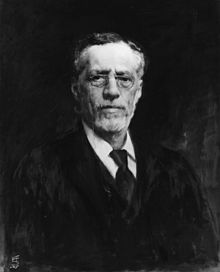Raphael Meldola FRS (19 July 1849 – 16 November 1915) was a British chemist and entomologist. He was Professor of Organic Chemistry in the University of London, 1912–15.
Raphael Meldola | |
|---|---|
 Raphael Meldola, by Solomon Joseph Solomon[1] | |
| Born | 19 July 1849 |
| Died | 16 November 1915 (aged 66) |
| Nationality | British |
| Alma mater | Royal College of Chemistry |
| Awards | Davy Medal (1913) |
| Scientific career | |
| Fields | Chemistry |
| Institutions | University of London |
Life
editBorn in Islington, London, he was descended from Raphael Meldola (1754–1828), a theologian who was acting minister of the Spanish and Portuguese Jews in London, 1804. Meldola was the only son of Samuel Meldola; married (1886) Ella Frederica, daughter of Maurice Davis of London. He was educated in chemistry at the Royal College of Chemistry, London. There is a portrait of Meldola (oil on canvas) by Solomon J. Solomon in the Royal Society collection; also a photograph by Maull & Fox, visiting card size.
Career
editMeldola worked in the private laboratory of John Stenhouse (FRS 1848). He was appointed Lecturer, Royal College of Science (1872) and assisted Norman Lockyer with spectroscopy. Meldola was in charge of the British Eclipse Expedition to the Nicobar Islands (1875) and was Professor of Chemistry, Technical College, Finsbury (1885).[2] He was also an entomologist and natural historian.
Meldola was a member of many scientific societies: Fellow of the Royal Astronomical Society; Fellow of the Institute of Chemistry; Fellow of the Chemical Society (London and Berlin); Member of the Pharmaceutical Society; The Geologists Association; The Royal Anthropological Institute; Entomological Society of London. He was elected Fellow of the Royal Society in 1886 (Charles Darwin was one of his proposers), awarded the Davy Medal in 1913, and was Vice-President of the Council from 1914–1915.
Meldola was President of the Entomological Society, 1895–1897; the Chemical Society, 1905–1907; Society of Dyers and Colourists, 1907–1910; Society of Chemical Industry 1908-1909; Institute of Chemistry, 1912–1915. He was the first president of the Maccabaeans, 1891–1915.[2] In his honour the Royal Society of Chemistry award the Meldola medal each year.
Mimicry
editMeldola was a keen naturalist, spending five years eagerly collecting evidence on mimicry in butterflies, inspired by Charles Darwin's On the Origin of Species. His work provided evidence for natural selection, acknowledged by the evolutionary zoologist Edward Bagnall Poulton in his book The Colours of Animals and thanked by Darwin for information on hexadactyly (a rare case of a person having six digits on each limb).[3]
Meldola Blue
editHe discovered the synthetic dye Meldola's Blue.[citation needed]
Notes
editThis article includes a list of general references, but it lacks sufficient corresponding inline citations. (February 2014) |
- ^ National Portrait Gallery, London
- ^ a b "Raphael Meldola - National Portrait Gallery". www.npg.org.uk. Retrieved 31 August 2021.
- ^ Travis, Anthony S. (2010). Deichmann, Ute; Travis, Anthony S. (eds.). Raphael Meldolda and the Nineteenth-Century Neo-Darwinians. Springer. pp. 88–118. ISBN 978-90-481-9901-3.
{{cite book}}:|work=ignored (help)
References
edit- Chisholm, Hugh, ed. (1922). . Encyclopædia Britannica (12th ed.). London & New York: The Encyclopædia Britannica Company.
External links
edit- Works by Raphael Meldola at Project Gutenberg
- Works by or about Raphael Meldola at the Internet Archive